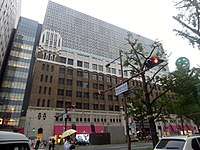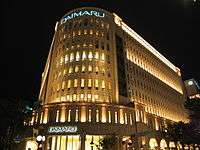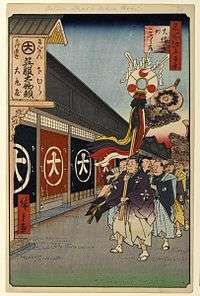Daimaru
Daimaru (大丸) is a Japanese department store chain, principally located in the Kansai region of Japan. The chain is operated by Daimaru Matsuzakaya Department Stores, a subsidiary of J. Front Retailing. At one time Daimaru was an independent company, The Daimaru, Inc. (株式会社大丸), headquartered in Chūō-ku, Osaka.[1]
| Public KK | |
| Industry | Retail |
| Fate | Merged with Matsuzakaya |
| Successor | Daimaru Matsuzakaya Department Stores Co., Ltd. |
| Founded | Kyoto, Japan (April 16, 1920) |
| Defunct | February 28, 2010 |
| Headquarters | Chūō-ku, Osaka, Japan |
| Products | Daimaru department stores Daimaru Peacock supermarkets |
| Revenue | 467.0 billion yen (2009) |
Number of employees | 3,292 (2007) |
| Parent | J. Front Retailing |
| Website | daimaru.co.jp/english/index.html |
History



Daimaru traces its history to Dai-Monjiya, a dry goods store in Kyoto founded by Shimomura Hikoemon Masahiro in 1717.[2][3] The name "Daimaru" was first used for a store in Nagoya called Daimaruya, which opened in 1728.
The chain was incorporated in 1907 and reincorporated as Daimaru Dry Goods K.K. in 1920, changing its name to Daimaru in 1928. For several years in the 1960s, Daimaru was the largest retailer in Japan. In the late 1970s, Daimaru was the first Japanese department store to open in Thailand, under the name Thai Daimaru. Its branches in Hong Kong closed in 1998,[4] and other branches in Melbourne Central (in direct competition with Myer and David Jones Limited) and the Gold Coast in Australia closed in 2002 after nearly a decade of low profits,[5][6] followed by Singapore in 2003.[7]
In 1960, Daimaru established a subsidiary called Peacock Sangyo. Now known as Daimaru Peacock, it operates 49 supermarkets in the Greater Tokyo Area, 28 in the Kansai region and 8 in the Chūbu region.
In 1998, Daimaru entered into a partnership with the French grand couturier Dominique Sirop to produce Dominique Sirop for Daimaru, a high fashion prêt-à-porter (ready-to-wear) label.
As of 2016, Daimaru had seven stores in Japan, and employed about 3,000 people.[2]
Locations (Japan)
- Shinsaibashi, Osaka - 7-1, Shinsaibashi Itchome, Chūō-ku. The main Daimaru department store, founded as Matsuya in 1726. Along Mido-suji. Daimaru's corporate headquarters were located nearby, at 4-10, Minamisenba Yonchome.
- Umeda, Osaka - 1-1, Umeda Sanchome, Kita-ku. Opened in 1983. At South Gate Building in the south of Osaka Station.
- Kyoto - 79, Shijo Takakura, Shimogyo-ku Kyoto. Opened in 1912. Along Shijo Dori, north-east side of Karasuma Station.
- Yamashina - 91, Takehana Takenokaido-cho, Yamashina-ku Kyoto. South of Yamashina Station.
- Kobe - 40, Akashicho, Chūō-ku, Kobe. Opened in 1927. Located in the south of Kyukyoryuchi-Daimarumae Station.
- Tokyo - 9-1, Marunouchi Itchome, Chiyoda-ku, inside the new North Tower of the Tokyo Station Twin Towers. Opened in 2007.
- Urawa PARCO - Urawa-ku, Saitama
- LaLaPort Yokohama - Tsuzuki-ku, Yokohama
- Sapporo - 4-7, Kitagojonishi, Chūō-ku, inside Sapporo Station. Opened in 2003.
- Stores operated by subsidiary companies in Fukuoka and Nagasaki (Hakata Daimaru K.K.), Shimonoseki, Tottori, Imabari, and Kōchi.
References
- "会社概要." Daimaru. January 27, 1998. Retrieved on December 15, 2010. "本社ビル所在地 大阪市中央区南船場4丁目4番10号"
- Stuart D.B. Picken (19 December 2016). Historical Dictionary of Japanese Business. Rowman & Littlefield Publishers. pp. 110–. ISBN 978-1-4422-5589-0.
- Japanese Yearbook on Business History. Japan Business History Institute. 1996. p. 114.
- Lui, Tai-Lok. Gordon, Mathews. [2001] (2001) Consuming Hong Kong. HK University Press. ISBN 962-209-546-1.
- Kate Tozer (21 June 2002). "Melbourne's Daimaru closes down". The World Today. Australian Broadcasting Commission. Retrieved 12 March 2013.
- Lyall Johnson (June 20, 2002). "Daimaru to go out with a bargain or two". The Age. Fairfax Media. Retrieved 12 March 2013.
- Australian Business Intelligence (July 2, 2002). "Daimaru of Japan says it will close all stores overseas". HighBeam Research. Archived from the original on March 4, 2016. Retrieved 12 March 2013.
External links
- Daimaru official website
- Daimaru official website (in Japanese)
- "Company history books (Shashi)". Shashi Interest Group. April 2016. Wiki collection of bibliographic works on Daimaru
| Wikimedia Commons has media related to Daimaru. |
